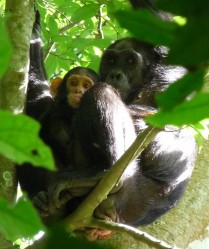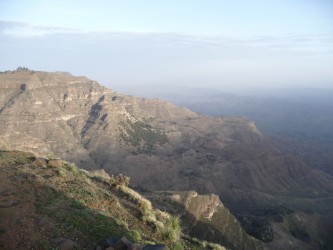
After all the excitement of the elections, I took the chance to have a couple of weeks off in Uganda and Ethiopia.
Now I try not to think about work when I’m having some down time. But when your work is about climate change, you can’t help but think about it on every new journey and in every new country or landscape.
This time it was the forests that really struck me – or the lack of them.
In Uganda I visited the Budongo Forest at the southern end of the Murchison Falls National Park. The National Forestry Authority reports that 77% of the forest has been cut at least once, and Budongo is described as being in a ‘state of degradation’. Fortunately, parts of the forest have now become the Budongo Forest Reserve, in order to protect the forest and the chimps who live there, who have been habituated to humans to allow for their continued protection. I spent an afternoon tracking the chimps by listening to them communicate with one other and finding their recent feeding sites and I managed to get close enough to a mother chimp and her baby to take a decent photo. The forest ranger told me that the forest is home to 600–700 chimpanzees, though they are threatened not only by hunters’ snares but also by the commercial logging, illegal pit sawing and human encroachment that has taken place over the last hundred years.

In Ethiopia, I learnt that over 1% of the country’s forests disappeared every year between 2000 and 2005. This has left only 12% of the country covered in forests – down from 30% in the late nineteenth century. It means that Ethiopia falls into the ‘high deforestation’ category of countries. These problems are driven by the collection of wood for fuel, expansion of agriculture into forest areas, and forest fires. Despite forests disappearing to make room for extra agriculture – in a country where over 80% of people depend on agriculture for their livelihoods and around 40% of GDP is based on agriculture – this deforestation degrades the land and means that agriculture becomes ever less productive.
It took me two days, 50 kilometres of hiking and 700 metres of climbing at altitude to get to the highlands for this photo. It's taken from the hut which formed my bedroom in a community campsite set up for visiting hikers. Each night community members would light the main hut, cook for us and make us tea and coffee, all by means of an open fire. They explained that they try and use eucalyptus wood for these fires - which burns slowly and brightly but grows quickly - rather than their indigenous trees, which they are losing more quickly than they can be replaced with new trees.
These examples from Uganda and Ethiopia are all part of a much bigger picture, since deforestation accounts for approximately 20% of all greenhouse gas emissions. The equivalent of around 36 football pitches of forests disappear every minute across the globe.
The UK government is already doing a lot to reduce deforestation and degradation of forests, and to encourage the planting of new trees where they have been lost.
Three of the programmes I work on focus on this area: the Forest Investment Programme, the Forest Carbon Partnership Facility, and the Congo Basin Forest Fund. These programmes, between them, help developing countries to plan how they’re going to reduce deforestation and degradation; invest in programmes that reduce deforestation and degradation and reform countries’ policies to manage forests better; and finally deliver payments for reducing emissions from deforestation, including through the carbon market.
There are also some great programmes in individual countries. Ethiopia has a huge tree-planting programme: 687 million trees were planted in 2008 as part of the UN Environment Programme’s Billion Tree Campaign.
And forestry also provides some of the most innovative new ways to deliver aid, known as ‘results-based aid’. This is one of the new government’s top priorities for how we ensure that UK aid achieves the best possible value for each pound of the taxpayer’s money, especially in such difficult economic times. Norway is providing an example through their contribution to the Amazon Fund, whereby payments are calculated on the basis of the emissions reductions that have actually been achieved through reducing deforestation.
The amount of international focus on protecting the world’s forests gives real cause for optimism. And for boosting your sense of hope, I discovered there’s nothing quite like tracking chimps through a beautiful forest reserve and spending a little time in their company.

Recent Comments